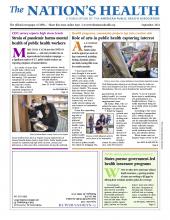
Bogota, Colombia, has seen a decline in emissions, a study published in July says.
Photo courtesy DC_Colombia, iStockphoto
25 cities cited for high carbon emission
Twenty-five cities produce over half of the world’s urban greenhouse gas emissions, a new study finds.
Published in July in Frontiers in Sustainable Cities, the study was designed to monitor the effectiveness of policies to reduce greenhouse gas emissions in 167 cities, resulting in the first “global balance sheet” of such emissions. Researchers found that the top 25 cities accounted for 52% of total urban greenhouse gas emissions, with cities in Europe, Australia and the U.S. having much higher per-capita emissions than cities in developing areas.
Megacities in Asia were significant greenhouse gas emitters.
“Although Asian cities are the biggest carbon emitters in totals, the per capita GHG emissions of cities in developed countries are still generally higher than that in developing countries,” the study said.
Top cities with the biggest per-capita decreases in emissions were Oslo, Norway; Houston, Texas; Seattle, Washington; and Bogota, Colombia.
Increase in mosquito disease highly likely
Billions more people will be at risk of dengue and malaria if climate change worsens, a new study finds.
Published in July in The Lancet Planetary Health, the study estimated exposure risk to the mosquito-borne diseases in the worst-case scenario that temperatures rise by about 3.7 degrees Celsius by 2100 compared to pre-industrial levels. Warming temperatures from climate change are expected to allow mosquitoes to spread and stay alive for more seasons in a year.
For malaria, the worst-case scenario estimated a total of 8.4 billion people at risk for the disease in 2078, compared to an average of 3.7 billion people at risk between 1970 and 1999. For dengue, a total of 8.5 billion people would be at risk in 2080, compared with an average of 3.8 billion between 1970 and 1999.
The study found an overall increase in the number of people at risk for malaria and dengue over the century.

Women gather water in Ethiopia, one of many countries where safe drinking water is in short supply, a new global report says.
Photo by Hadynyah, courtesy iStockphoto
Safe water, sanitation lacking in many states
Unless progress speeds up quickly, billions of people will be left without access to safe water, sanitation and hygiene by 2030, warn global health officials.
In July, UNICEF and the World Health Organization released a new report showing that in 2020, about 1 in 4 people lacked safely managed drinking water in their homes and nearly half the world’s population did not have access to safely managed sanitation. By the start of the COVID-19 pandemic, 3 in 10 people worldwide still could not wash their hands with water and soap at home.
For more information on “Progress on Household Drinking Water, Sanitation and Hygiene, 2000-2020,” visit www.unicef.org.
WHO issues cervical cancer guideline
In July, the World Health Organization issued a new screening guideline for cervical cancer — a preventable and treatable disease that still kills hundreds of thousands of women each year.
In particular, WHO now recommends a human papillomavirus DNA-based test as the preferred screening method, rather than visual inspection with acetic acid or a Pap smear, which are the most commonly used methods to find pre-cancer lesions. The guideline also includes new recommendations specifically for women with HIV, who face a much higher risk of cervical cancer.
WHO’s global strategy for cervical cancer elimination calls for 70% of women worldwide to be screened regularly for cervical disease with a highperformance test, and for 90% of those who need treatment to receive it.
That strategy — combined with vaccination against HPV, which causes most cervical cancers — could prevent more than 62 million deaths over 100 years.
For more on the “WHO Guidelines for Screening and Treatment of Cervical Pre-Cancer Lesions for Cervical Cancer Prevention,” visit www.who.int.
- Copyright The Nation’s Health, American Public Health Association









